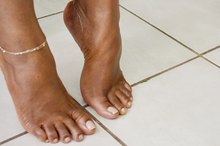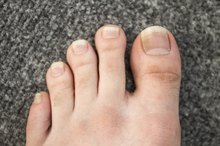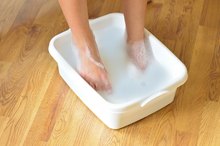What does fact checked mean?
At Healthfully, we strive to deliver objective content that is accurate and up-to-date. Our team periodically reviews articles in order to ensure content quality. The sources cited below consist of evidence from peer-reviewed journals, prominent medical organizations, academic associations, and government data.
The information contained on this site is for informational purposes only, and should not be used as a substitute for the advice of a professional health care provider. Please check with the appropriate physician regarding health questions and concerns. Although we strive to deliver accurate and up-to-date information, no guarantee to that effect is made.
How to Kill Toe Nail Fungus
Onychomycosis, or toenail fungus, is a contagious infection that causes yellowing, thickening and crumbling of the nail. In severe cases, there may also be pain and swelling, and the nail may lift from the nail bed and make wearing shoes difficult. Fungal nail infections develop when fungi enter through a small cut in the nail and then multiply. Approximately 12 percent of all Americans are affected by fungal nail infections, according to the American Academy of Dermatology 1.
Cut your nails straight across and as close to your skin as possible. Trimming your nails will enable topical medications to reach deeper into the infected area and will reduce pressure and pain on your nail bed when walking.
Ingrown Thumbnail
Learn More
Soak your affected toes in a solution of 2 parts warm water to 1 part vinegar for 20 minutes, twice daily. The vinegar will help kill the infection by altering the pH of your skin, making it inhospitable to the fungus responsible for your symptoms. MayoClinic.com recommends reducing the frequency of these soaks if you experience skin irritation 2.
Apply an antifungal lacquer, which is similar to nail polish, if your infection is localized to a small area of your nail. These medicated polishes are available by prescription.
Home Remedy for a Red & Swollen Fingernail
Learn More
Use a topical medication for minor infections or in conjunction with oral medications to speed recovery and help prevent re-infection. Topical antifungal medications are available over the counter and by prescription.
Try an oral antifungal medication, such as terbinafine or itraconazole, to treat severe infections that fail to respond to topical treatments and home care. The National Institutes of Health website states that prescription-strength oral antifungal medications effectively kill toenail fungus in about half of patients 3. Unfortunately, these medications may cause severe side effects and are not appropriate for people with liver problems.
Undergo surgery to remove part or all of your nail. In severe and persistent cases, removing the nail may be the only treatment option to kill the fungus and prevent a recurrence.
Wear shoes when walking in public restrooms and locker rooms, use an antifungal spray or powder inside your socks and stop wearing colored nail polish to encourage healing and prevent re-infection.
Wash your hands after touching affected nails and sterilize nail clippers with isopropyl alcohol before storing. Fungal infections are highly contagious and can spread from one nail to another quickly. It is also possible to pass the infection to other members of your household.
Related Articles
References
- American Academy of Dermatology: Nail Fungus and Nail Health
- MayoClinic.com: Nail Fungus
- National Institutes of Health, Medline Plus: Fungal Nail Infection
- Merck Manual Professional Version. Onychomycosis. Updated August 2019.
- Richardson M. Selecting a treatment option in subungual haematoma management. Nurs Times. 2004;100(46):59, 61, 63.
- MyHealth Alberta.ca. Toenail or fingernail avulsion: Care instructions.
Writer Bio
Sandra Ketcham has nearly two decades of experience writing and editing for major websites and magazines. Her work appears in numerous web and print publications, including "The Atlanta Journal-Constitution," "The Tampa Bay Times," Visit Florida, "USA Today," AOL's Gadling and "Kraze Magazine."









